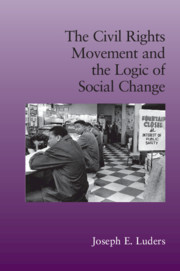6 - Federal Responses to Civil Rights Mobilization
Published online by Cambridge University Press: 05 June 2012
Summary
In spectacular fashion, Lyndon Johnson signed the landmark Civil Rights Act of 1964, a decade after the Supreme Court in Brown v. Board of Education had declared segregation unconstitutional and after hundreds of civil rights protests had awakened the nation to the profound injustices in the Jim Crow South. The civil rights movement had won a sweeping victory and, the following year, achieved another success in the Voting Rights Act. Other major acts followed. Studies of the outcomes of political movements in general and the civil rights movement in particular offer different explanations for these events, though most concentrate on disruption costs in the form of movement events, public opinion, and mass attentiveness as well as contextual political opportunities (such as the partisan composition in Congress). Research specifically on the civil rights movement has documented a “critical dynamic” in which segregationist violence elevated national attentiveness that, in turn, prompted supportive federal intervention. This research explains movement outcomes based on the convergence of supportive public opinion and issue salience stemming from the movement's effective provocation of dramatic events. These studies are informative, their arguments compelling, and therefore my intent is not to displace them. Yet, despite their many virtues, certain aspects of the civil rights struggle merit closer scrutiny.
Perhaps due to an emphasis on protests and dramatic episodes of violence, the full range of disruption costs is seldom sufficiently addressed, particularly the place of conventional political leverage in winning policy gains.
- Type
- Chapter
- Information
- The Civil Rights Movement and the Logic of Social Change , pp. 142 - 190Publisher: Cambridge University PressPrint publication year: 2010

